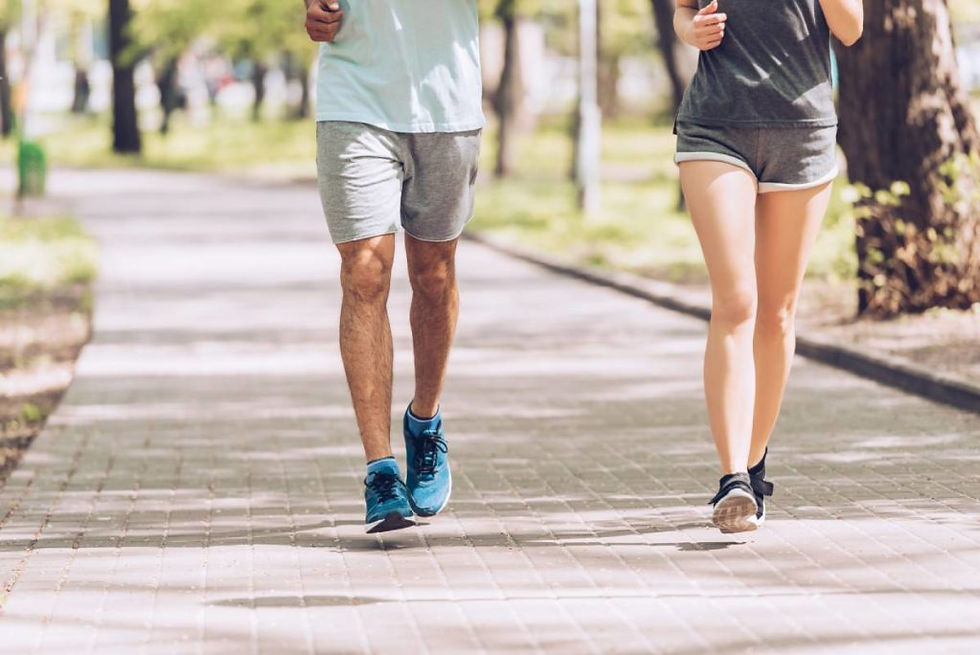EMBRACING MINIMALIST SHOES: A STEP TOWARDS HEALTH AND COMFORT
- Team PhysioQinesis : Credit Viraj Shah
- Feb 16, 2024
- 3 min read

In recent years, minimalist shoes have gained popularity as a footwear choice for those seeking a more natural and comfortable way of walking and running. These shoes, often characterized by their lightweight design and thin sole, aim to mimic barefoot movement. In this blog, we will explore the uses, effects, and considerations of minimalist shoes, helping you decide if they are the right fit for your lifestyle.
Description of Minimalist Shoes :
1. Thin Soles :
Minimalist shoes feature thin soles for a close-to-ground feel, enhancing proprioception and replicating a barefoot experience.
2. Zero to Low Heel-to-Toe Drop :
Minimalist shoes typically have minimal or zero heel-to-toe drop, promoting a neutral foot position and natural gait.
3. Wide Toe Box :
Designed with a wide toe box, minimalist shoes allow for natural toe splaying, enhancing stability and preventing toe compression.
4. Lightweight Design :
Characterized by a lightweight build, minimalist shoes provide a sense of freedom and agility during various activities.
5. Flexibility :
Prioritizing flexibility, minimalist shoes support unrestricted foot movement, contributing to natural biomechanics and muscle engagement.
6. Limited or No Arch Support :
Minimalist shoes often lack artificial arch support, encouraging the natural arch of the foot and promoting overall foot strength.
7. Breathable Materials :
Crafted from breathable materials like mesh and lightweight synthetics, minimalist shoes reduce moisture-related issues and enhance ventilation.
8. Simplicity in Design :
Minimalist shoes embrace a simple and uncluttered design, focusing on essential elements for protection and comfort.
9. Versatility :
Suitable for walking, running, and everyday wear, minimalist shoes offer versatility in various activities.
10. Toe-to-Heel Flexibility :
Minimalist shoes exhibit flexibility from toe to heel, allowing the foot to move naturally and adapt to different surfaces.
The Benefits of Minimalist Shoes
1. Improved Biomechanics :
Minimalist shoes encourage a more natural walking and running gait, promoting better biomechanics. By allowing your feet to move more freely, these shoes can strengthen the muscles in your feet and lower legs.
2. Enhanced Sensory Perception :
The thin sole of minimalist shoes provides a closer connection to the ground, allowing your feet to better feel the terrain. This enhanced sensory perception can contribute to improved balance and proprioception.
3. Increased Foot Flexibility:
Traditional shoes often restrict the natural movement of the foot. Minimalist shoes, on the other hand, allow for greater flexibility, enabling the foot to move more freely and adapt to various surfaces.
Considerations and Potential Adverse Effects :
1. Transition Period :
It's essential to acknowledge that transitioning to minimalist shoes may take time. Start gradually, allowing your feet and muscles to adjust to the new movement patterns to avoid potential injuries.
2. Terrain Considerations :
While minimalist shoes are excellent for many activities, they may not be suitable for all terrains. Consider the surfaces you'll be walking or running on and choose the appropriate footwear accordingly.
3. Individual Variability :
Not everyone will experience the same benefits from minimalist shoes. Factors such as foot shape, previous injuries, and personal preferences play a role in determining if these shoes are the right fit for you.
Choosing the Right Minimalist Shoes :
1. Proper Fit :
Ensure a snug but not tight fit to prevent unnecessary friction and discomfort. Pay attention to toe box width, arch support, and overall shoe shape to find the best fit for your feet.
2. Purpose of Use :
Different minimalist shoes cater to various activities. Consider the intended use, whether it's for running, walking, or everyday wear, and choose a pair designed for your specific needs.
3. Quality Materials :
Look for shoes made from durable and breathable materials. High-quality construction ensures longevity and comfort over time.
In conclusion, minimalist shoes can offer numerous benefits, from improved biomechanics to enhanced sensory perception. However, it's crucial to approach the transition thoughtfully and choose shoes that align with your individual needs and preferences. As with any footwear choice, it's recommended to consult with a healthcare professional or podiatrist to determine the best option for your unique foot anatomy and lifestyle. Embrace the minimalist movement cautiously, and you may find yourself taking confident strides toward a healthier and more comfortable way of moving.




Comments